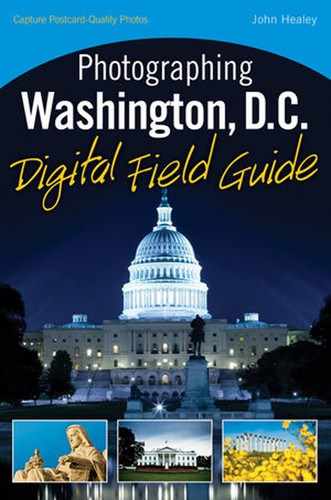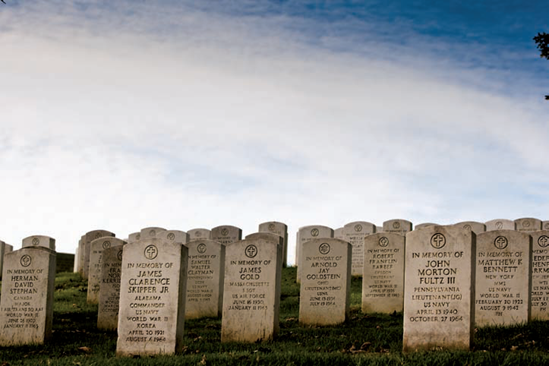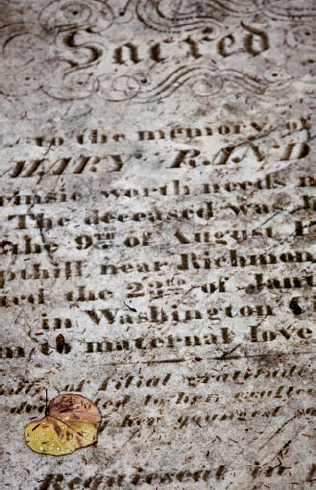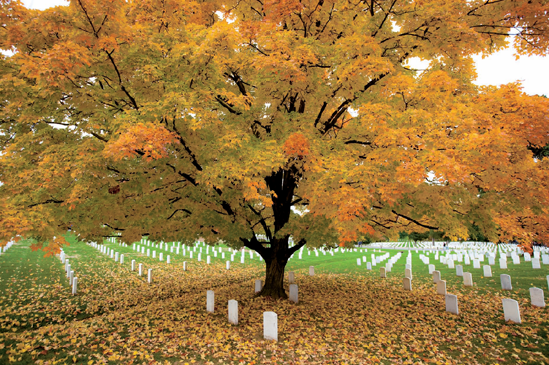
A fall view of Arlington National Cemetery. Taken at ISO 200, f/5, 1/60 second with a 20mm lens.
Arlington National Cemetery is the United States' national military cemetery, as well as a shrine honoring the men and women who served in the United States Armed Forces. Veterans are buried here from all of the wars the United States has engaged in, from the American Revolution to the wars in Iraq and Afghanistan. In addition to those who served in the Armed Forces, two former presidents (William H. Taft and John F. Kennedy) are buried here. Several other monuments and memorials are also significant features of Arlington Cemetery.
Both iconic and creative photos can be made at the Tomb of the Unknown Soldier, along Memorial Drive, and at the gravesite of architect Pierre L'Enfant.
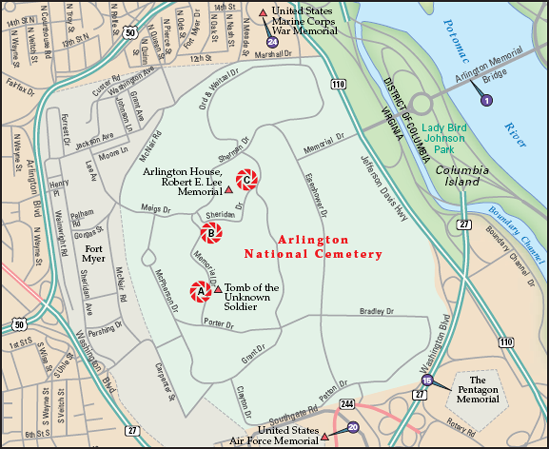
Figure 2.1. The best locations from which to photograph Arlington National Cemetery: (A) the Tomb of the Unknown Soldier, (B) Memorial Drive, and (C) the gravesite of Pierre L'Enfant. Nearby photo ops: (1) Arlington Memorial Bridge, (15) Pentagon Memorial, and (24) United States Marine Corps War Memorial.
Also known as the Tomb of the Unknowns at Arlington National Cemetery, this sarcophagus overlooks Washington, D.C., and was originally a tomb to the Unknown Soldier of World War I. Today it represents the unknown soldiers who have all died serving in the United States Military.
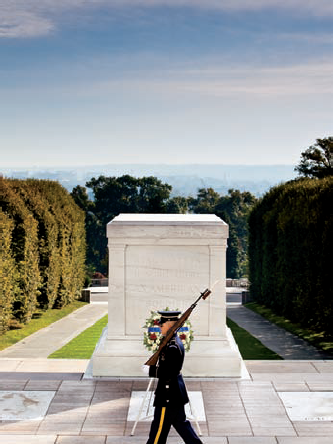
Figure 2.2. A U.S. Army 3rd Infantry Tomb Guard at the Tomb of the Unknown Soldier (see A on the map). Taken at ISO 400, f/7.1, 1/800 second with a 90mm lens.
The Tomb is guarded 24 hours a day, 365 days a year by specially selected volunteers of the 3rd U.S. Infantry (The Old Guard). These Tomb Guard sentinels are considered to be the most elite soldiers of the 3rd U.S. Infantry (see Figure 2.1).
The Tomb Guards change in an elaborate, historical ritual that is open to the public during the hours Arlington Cemetery is open (see Figure 2.2). From October 1 to March 31, the ceremony is repeated every hour. From April 1 to September 30, the ceremony is repeated every 30 minutes.
Arlington National Cemetery consists of over 600 acres of land where more than 300,000 people are buried. It is an expanse of rolling hills that is at once beautiful and somber.
A walk from the Visitor's Center along Roosevelt Drive heading west will take you to the Tomb of the Unknown Soldier, and from there you can walk just west to see several monuments and memorials. From there you can walk north on Memorial Drive and follow Sheridan Drive to your right, now heading east (see Figure 2.3).
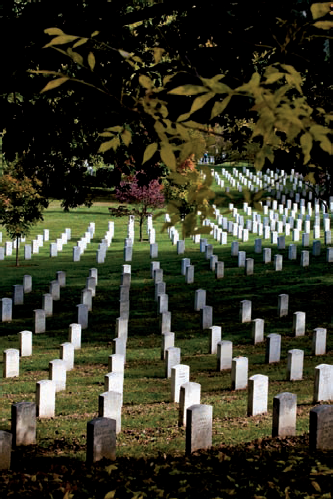
Figure 2.4. A view from Arlington National Cemetery along Sheridan Drive (see B on the map). Taken at ISO 100, f/8, 1/320 second with a 130mm lens.
This route takes you past several prominent areas of the cemetery as well as giving you a sense of the vast number of people who have been buried here (see Figure 2.4).
In front of the Robert E. Lee house and overlooking Washington, D.C., is the grave of Pierre L'Enfant (see Figure 2.5). He was a French-born architect and engineer who was a volunteer in the American Revolutionary Army. George Washington hired L'Enfant to create the original plan for Washington, D.C. It was under his guidance that the Capitol and White House are where they are today, as well as much of downtown Washington, D.C.'s organization.
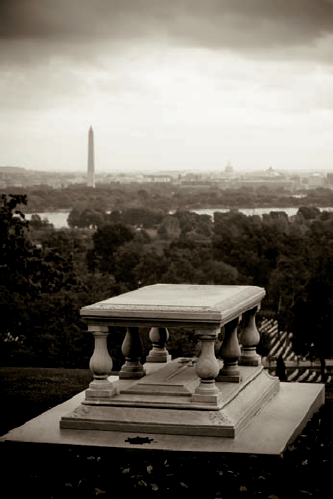
Figure 2.6. The gravesite of Pierre L'Enfant (see C on the map). Taken at ISO 400, f/8, 1/320 second with a 90mm lens.
L'Enfant devised D.C.'s roads so that there would be many intersections that allowed for statues to be erected, as well as for wide, sweeping avenues throughout the city. He was eventually fired by Washington after several heated disagreements. His plan, however, was largely followed throughout the continual building of the city.
First and foremost, a walk through Arlington National Cemetery is a way to honor those who have helped make the United States what it is today and to remember their service. Realizing the significance of the cemetery will go a long way in helping you make memorable images.
It's a good idea here to pack lightly so you can walk a lot to explore the area.
You can make a wide variety of pictures at the cemetery, so really there's quite a large range of lenses that could conceivably work. However, using a lens that is between 70 and 150mm when photographing the cemetery grounds works well to compress the land and create a more striking image of the many graves here.
When photographing at the Tomb of the Unknown Soldier, it is required that you stay quiet. If you are using a dSLR, be sure to have it on a single-frame drive mode so that you don't make too much noise when you press the shutter. Shoot sparingly and try to avoid making noise when there is silence during the ceremony. For this reason, point-and-shoot cameras are a good idea here, since they are often noiseless. However, make sure any sound effects are turned off as well. It's unfortunately not uncommon when witnessing the Changing of the Guard to hear the faked electronic sound of a point-and-shoot camera taking a photo.
During most days, the white marble here is very, very bright (see Figure 2.6). Many cameras will not meter the scene here correctly because it is so bright. You can correct this by using your exposure compensation dial and adding exposure or, if you have a fully automatic camera, you may try to use its Beach or Snow setting (both are designed to more faithfully reproduce very bright scenes).
Because the cemetery is so scenic, good photos can be taken at any time of the day — but great ones can be taken in beautiful light.
The golden hours of morning and evening are nice times to be at Arlington National Cemetery. Especially in the fall and winter, the light will arc across the acres of land here and create beautiful scenes.
Foggy, rainy, or snowy weather will help to make your images unique here. There are few places where you can go to take cover from the elements, so be prepared if inclement weather is predicted.
The cemetery is not open during the night to the public. It closes at 7 p.m. from April 1 to September 30, and from October 1 to March 31, it closes by 5 p.m.
There are hundreds of vistas and unique vantage points within the cemetery grounds. Aside from taking photos of the many rows of graves, keep an eye out for smaller details (see Figure 2.7). Also there are many unique memorials and monuments that can be photographed; see the visitor center for a map that has a list of all of them.
